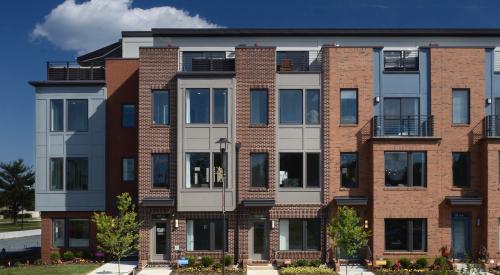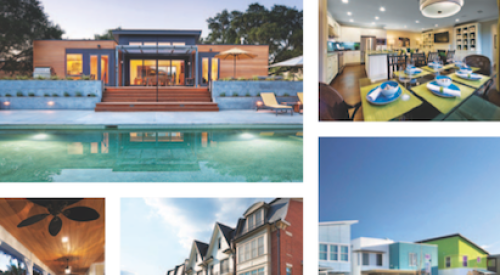|
Thank the Internet, TV shows, special-interest publications, local home-improvement centers and even your competition for inspiring your budget-conscious buyer. These days, even the thriftiest shoppers expect more bang for their buck. To catch their eye and make the sale, you have to give them a product that packs a visual punch and gives them the style and amenities they want, without busting their bottom line — or your own.
 |
|
|
|
Good, cost-efficient design begins with a simple four- or six corner footprint that can be dressed up with color and architectural detailing. Also consider land plans that feature smaller yards in favor of boosting community space. And never, however, overlook the importance of some type of indoor-outdoor connection in the homes. |
"This is particularly true at the lower price points," continues Davis, "where being able to reduce costs by $2,000 to $5,000 dollars and still give the buyer what they are looking for can make the difference between them owning a home of their own or staying put in an apartment."
The Indianapolis-based residential construction firm is a leader in a region that consistently ranks at the top of the country's most affordable major housing markets.
Builders should consider the age, income and lifestyle of their buyer market profile, say housing industry experts. Each of these affects the housing product in terms of living space and amenities.
Knowing your buyers and designing homes to meet their specific needs is critical, agrees architect Daniel O'Malley, principal with BSB Design's Chicago regional office. "This makes a tremendous difference in what features are important in a home and where you can cut back."
"It all comes down to recognizing what your buyer is willing to spend their money on," says John Bean, C.P. Morgan's director of design.
"The key to dressing up an affordable product is good merchandising in your models," says Deanna Sihon, vice president of consulting with New Home Trends, a Bothell, Wash.-based research and marketing consulting firm that tracks data on new home construction.
Builders who are willing and able to adapt quickly to meet the changing needs and preferences of their buyers and do it cost-effectively are likely to be the most successful.
Here are a few suggestions for keeping costs in line without sacrificing style or excitement.
Rethink construction details, materials"There are cost implications in everything we do when we design a home," says O'Malley. "The cost/value/benefit ratio must be carefully studied in order to make the right decisions when it
 |
|
|
|
Identify what your target buyer perceiveds as most desirable for their lifestyle and then deliver. Remember, buyers are often willing to make tradeoffs in some areas to get what they want in others, says John Bean of C.P. Morgan Communities. Lower ceilings, open floor plans and controlled lighting are all key features of cost-efficient design. Corners and nooks can provide space for built-ins. |
For O'Malley, the design process begins by addressing the shell of the building. The goal for an affordable home, he says, is to create a four- or six-corner structure. This simplifies everything that follows: the foundation, the framing of the walls and the roofline.
"A good, simple plan is developed from the outside in," O'Malley continues.
Builders can also save money by backing off on the soaring ceilings heights that have been a standard feature in homes in even the most affordable markets over the past 25 years.
"Lowering ceiling heights is a good way to save on lumber," says architect John Thatch, design principal for Dahlin Group Architecture in Pleasanton, Calif. "Not only does this reduce materials costs, but it also boosts energy efficiency."
When it comes to selecting construction and finish materials, builders should think long-term rather than focusing simply on the immediate costs, recommends Thatch.
Some other cost-cutting measures include:
- Limiting variations in roof truss size
- Choosing floor framing systems that use I-joists or floor trusses that permit longer spans, reducing the need for load-bearing interior walls
- Vertically stacking plumbing cores
- Installing composite roofing materials that offer the dual benefit of being lightweight and durable
- Using high-quality engineered materials to reduce costs and callbacks
Simplifying the residential "box" doesn't relegate an affordable home's exterior elevation to the land of bland.
"We can take that simple form and add all kinds of character to it with applied elements such as verandas, gables, accent siding and trim details," says Thatch.
"We encourage builders to put their dollars where it will have the most impact," agrees O'Malley,
 |
 |
|
Kitchen islands (top) remain at the top of the list of must-haves for homes in all price ranges. The bigger the better, say the experts; islands can serve a variety of functions at the same time, from meal prep to homework center and room divider. Choosing high quality exterior finish materials (right) actualls cuts costs by reducing callbacks. Narrow-frontage homes require less accent material to add visual interest, says builder Eric Campbell. |
"We are really moving toward the not-so-big house today," says Campbell. "People are looking for less square footage but higher quality. In the past, everyone tended to measure the value of a home based on its size alone. But that's really a poor use of the cost-per-square-foot equation. If you use space more efficiently, you can actually reduce the square footage of a home significantly and still have the same size rooms."
O'Malley calls this "uncluttering" a plan, or fine-tuning it to maximize functional space for the homeowner and eliminate what they don't need.
One area to never cut back on in terms of drama, say the experts, is in the entry. Creating a high-impact line of sight in this part of the home, either by establishing a long view through the interior or by providing vertical views up into loft space, will make even the most affordable home appear to be more spacious.
And when it comes to the master bathroom, builders should continue to maximize its impact by giving it a spa-like feel.
Think about:
- Creating "swing" rooms that give homeowners a choice in how the space can be used to suit their needs
- Minimizing interior hallways
- Eliminating multiple bathrooms in favor of a larger hall bathroom to serve the secondary bedrooms
- Adding 6- to 8-inch depth to the powder room make it feel larger without affecting the overall space planning in the home
- Providing options for finished space in basements, above garages or in the attic
- Continuing to focus on the kitchen as the command and entertainment center with triangulated designs that promote visual connections
- Designing multipurpose mud rooms with built-in stop-and-drop centers to catch clutter
When it comes to budget-friendly products and materials, there are more options on the market today than ever before, says Sihon. Some suggestions:
- Get on board the green bandwagon. High-efficiency, environmentally friendly materials and products reduce maintenance and operating costs for the homeowner.
- Standardize wherever possible
- Use composite rather than hand-milled wood trim and choose simplified profiles
- Opt for a single- rather than double-bowl vanities
- Decrease the size of secondary bedrooms PB
|
















